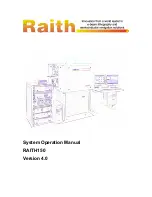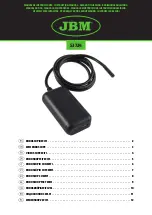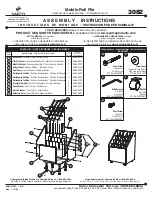
SM2 Microphone Interface Instructions
The SM2 is a single channel interface for use with all SM1 series microphones. It provides a convenient way of supplying
power to the SM1, installer friendly termination of the cable runs and a standard RCA or 3.5mm audio output connector.
The SM2 easily connects to recording equipment such as DVRs, I/P cameras and audio recorders. Note the audio output
signal of the SM2 is “line level” (0dbm).
SM1 Microphone Placement
Locate the SM1 microphone as close as possible to the area of interest in the space to be monitored. If a large area is to
be monitored, locate the SM1 in the middle of the room. Do not mount the microphone near air conditioning vents, light
fixtures or electrical equipment. The SM1 should be placed as close as possible to the subject(s) to be monitored. The
SM1 is still useable at distances of up to 25 feet but is dependent on the level of background noise in the area.
Experimentation in the environment will determine what distances work best.
SM2 location and power
The SM2 interface box is designed to be located next to a DVR or I/P camera. The SM2 requires a 120VAC power source
within 3 feet of its location. If this is not possible in your application, you can splice in up to 100 feet of 18 awg, 2
conductor cable to extend the distance between the AC power source and the SM2.
Cable Run
Run a 22 gauge, stranded, two conductor shielded cable between the SM2 interface and the SM1 microphone. Keep the
cable run distance under 1,000 feet and away from AC power sources, light fixtures and electrical equipment.
See Figure
1 for connection diagram.
Mounting
The SM1 can be surface or flush mounted on ceilings or walls. For flush mounting, cut a 2 ¼” by 2
¾
“ hole in the wall or
ceiling tile to allow room for the circuit board and mount the SM1 to the surface with screws. For surface mounting,
purchase the SM1S surface mount adapter or use a single gang electrical box.
Adjusting the SM1 Gain
Start with a midrange setting of the gain control on the SM1. Adjust the c or – for maximum clarity. If the sound at
the amplifier is distorted, rotate the control towards the – mark (counter- clockwise). If the volume at the amplifier is too
low, rotate the control towards the + mark (clockwise). Set “Vol range” jumper per instructions below.
The “Volume Range” jumper should be set to the “LO” position when using the SM1 with I/P cameras that utilize
“microphone inputs” also known as “Mic. Level” inputs. This sets the maximum gain of the SM1’s pre-amp to x14. The
jumper should be placed in the “HI” position when using “Line level” inputs of DVRs and I/P cameras. This sets the
maximum gain of the SM1’s pre-amp to x196.
The SM1 is shipped with the gain set at midrange. If the sound at the “head end” is distorted, rotate the control towards
the – mark (counter-clockwise). If the volume at the “head end” is too low, rotate the control towards the + mark
(clockwise).
Setting the SM1 Hi-Cut/Lo-Cut Jumpers
The normal frequency response of the SM1 microphone is 500-13Khz. When both jumpered “in”, The “HI Cut” and “Lo
Cut” filters set the SM1’s frequency response to 900-6Khz . Enabling one or both of the filters is useful when background
noise needs to be further reduced and intelligibility of speech emphasized. We recommend experimenting with the jumper
settings to achieve the best acoustic result for your application.




















